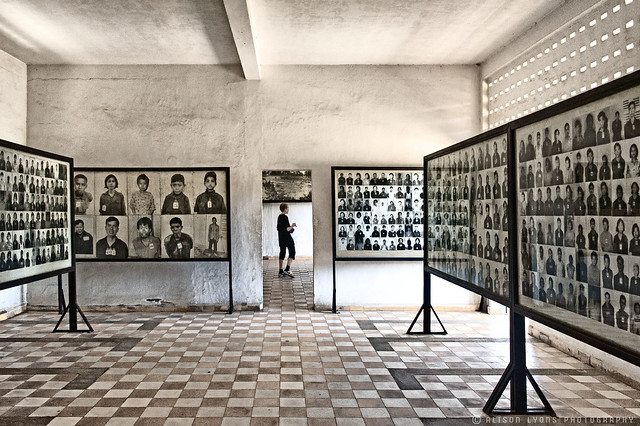We spill out of the taxi at the Genocide Museum. It is uncomfortably hot.
“How long should we stay here?” we ask our driver. He shrugs. “Its up to you.” he says. He points to a shady spot up the road. “I will wait there for you.” He gestures with his head.
As I approach the ticket office, a man looms in front of me, his face, hideously disfigured... from I can’t imaging what. I turn away, completely confronted. I have never see such deformity. I don’t know what to think. The moment is quickly suppressed from my memory as I focus on what lay ahead.
Inside the gates, the “prison” surrounds three sides of an open courtyard. There is little shade and so we head for the nearest building. This used to be the Chao Ponhea Yat High School, but was converted to a prison during the “reign” of Pol Pot.
The first room I enter is strangely familiar. I have seen photos of it, so the scene comes as no surprise. Images from this prison were featured in the 1992 Ron Fricke film “Baraka”, and it is a place I’ve always wanted to visit. The cheery yellow and white tiled floor was a happy legacy of its schooltime days. The lonely metal bed complete with shackles now a reminder of the horror of its more recent history.
Perhaps because of the confines of the walls, I find this place more disturbing than the killing fields. Perhaps because I find torture so much more disturbing than death. Perhaps because it it is easier to visualise what took place here... or perhaps it is the neverending wall after wall of photos. Photos of real people who were brought here, imprisoned, interrogated and tortured before being carted off in trucks to Cheung Ek to be killed, en masse.
There is one room after another, each one with a bed frame, perhaps a desk, perhaps an instrument of torture. On one wall of each “classroom” is a different photo. Taken by Ho Van Tay, a Vietnamese combat photographer who was the first media person to document Tuol Sleng to the world. The photos are a grisly portrayal of the tortured bodies shackled to the beds.
On the balcony outside, a sparrow flits from wire to wire. Barbed wire that was erected to keep the prisoners in.
We make our way to the second school building. This one was converted into cells. Where the “prisoners” were held captive for months on end.
Beyong the cells, there are rooms and rooms lined with photos. Each prisoner was photographed on arrival. The Khmer Rouge required that the prison staff make a detailed dossier for each prisoner. The original negatives and photographs were separated from the dossiers in the 1979–1980 period and most of the photographs remain anonymous today. Nameless faces. Wall after wall. There is a face of a little girl. She must be about 4 years old. She looks sweet, and of course, innocent of any political crime. The faces stare back. One man appears deranged with terror, the whites of his eyes circling his dark eyes as they nearly pop out of his head. His mouth is a grimace. He must know what fate lies before him. So many people, so many women, so many children. I looked into the eyes of many of the victims to try and see what emotions they may have been experiencing when photographed. Most seem detached and resigned to an unknown fate. A few seem terrified. Not as many as I expected. It beggars belief.
There is a sign on the wall. It is a diagram of a smiling man with red line slashed through it indicating that it is prohibited to smile or make jokes here. I wonder at the need to erect such a sign.
Faces on the wall
Subscribe to:
Post Comments (Atom)

No comments:
Post a Comment